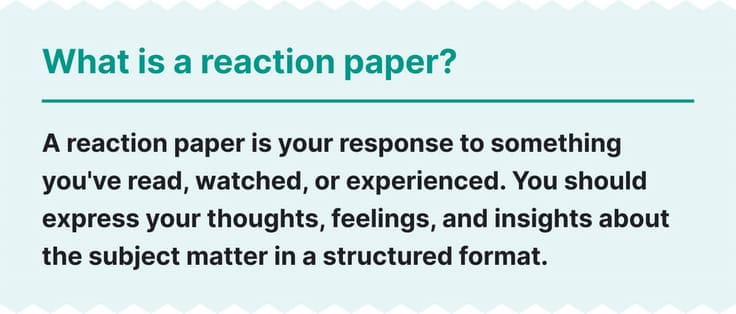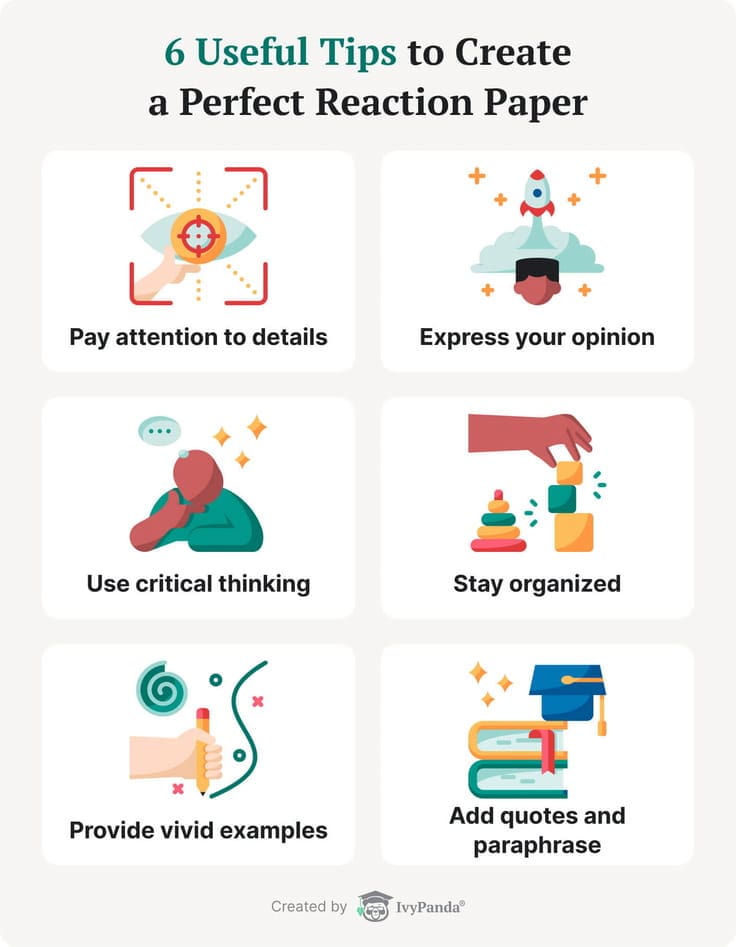Reaction Paper Maker Online Tool
The Reaction Paper Maker is designed to help you organize your thoughts into a clear, structured response. Whether you’re sharing your thoughts on a book, article, or event, this tool guides you in crafting a well-organized reaction paper that communicates your perspective effectively.
✨ Intro to the Free Reaction Paper Maker
Reaction papers are among the most common academic assignments college students work with. Such essays describe a person’s impression of an event, a book, a film, or a seminar. They also must reflect a student’s attitude toward the analyzed content and its quality.
Our reaction paper maker instantly creates high-quality examples that will inspire a great paper of your own. To help you even further, the IvyPanda.com expert team prepared a guide with valuable tips that you can check out below.
🔥 Reaction Paper Maker Free Tool: 5 Benefits
Our team developed this reaction paper generator to help students make the writing experience more pleasant and straightforward. You will find our tool helpful thanks to these qualities:
How to Use Our Reaction Paper Maker Online
Follow the steps below to use our tool:
- Indicate your title.
- Provide additional details about your topic.
- Mention the main issues you’d like to address.
- Click the “Make Reaction Paper” button.
- Get your reaction essay sample.
Remember that our reaction essay maker creates papers only as examples for your inspiration.
🔎 What Is a Reaction Paper?
Reaction papers are academic assignments students write in response to a particular topic, experience, or work. Such essays briefly summarize books, theater plays, or movies and convey your thoughts and feelings regarding the content.

To write an excellent reaction paper, it’s crucial to research the content carefully and provide your response to it in a structured manner. Besides, you should demonstrate your engagement with the material and ability to think critically. Your essay can also explain what the subject meant to you and how it impacted your life.
What Is the Difference between a Reaction Paper and a Reflection Paper?
There’s a common misconception that reaction and reflection papers are the same because of their similar-sounding names. However, there are several differences between them:
- Reaction papers describe a person’s feelings about a particular subject. They usually have a formal tone and include a writer’s opinion, work analysis, and supportive arguments.
- Reflection papers describe students’ lessons they’ve learned from an experience. Learners discuss initial thoughts and how an event changed them.
What Are the Different Types of Reaction Papers?
During your studies, you might come across several types of reaction papers. Each has its purpose within the academic setting.
Check them out below:
- Critical reaction paper. Here, you should critically evaluate the subject of your writing, either agreeing or disagreeing with the authors.
- Descriptive reaction paper. Such essays describe students' opinions about events, articles, books, or movies.
- Quantitative reaction paper. Professors assign such papers whenever the subject is measurable. This means that you should describe a topic in quantifiable terms.
What Are the Questions in Making Reaction Paper?
Before you begin writing your assignments, ask yourself these questions about the content of the work you’re reacting to:
- Which parts of the work do you agree or disagree with?
- How do you feel about the work?
- Do you identify with the author's position?
- What’s the best approach to evaluate this work?
📝 How to Write a Good Reaction Paper
Like with any assignment, writing a high-quality reaction paper requires you to complete several steps. You can combine the capabilities of our reaction paper maker with the following plan to get the best results:
-
Assess the work.
First, get familiar with your essay’s subject. If it's a book or a lecture, take notes about its key ideas, themes, and characters. Think about the author’s point of view and motives. After that, write down your thoughts about the work’s content. -
Make a thesis statement.
Create a thesis statement for your essay describing your opinion. The thesis is a central idea you wish to explore, and it should be a single sentence long. -
Create an outline.
Use your notes to write a template for your reaction essay. Having a detailed plan makes it a lot easier to write assignments. You can experiment with various outlines before settling on the best one. -
Write the draft.
Once you come up with a good outline, you can write the first draft. During this process, you may find crucial details missing in your outline or the structure not working as you wish. If so, it's worth trying your best to make it work. -
Edit and revise.
It’s essential to carefully proofread and edit the final essay. Make sure you cover important elements and provide honest opinions. Also, check your essay’s grammar, spelling, and logical flow.
Reaction Paper Structure
Like any academic paper, reaction essays follow a specific structure. Each component serves a particular function that ties them together and adds to their readability:
- Introduction. The first part of the reaction paper sets the stage for the rest of the work and shows what it will be about. Your introduction should give some context to the readers, briefly summarize relevant information, and explain what you wish to achieve with your reaction essay.
- Body paragraphs. In this section, you should provide your thoughts and opinions about the subject. You may also discuss specific aspects of the analyzed material and your feelings about it.
- Conclusion. A reaction paper's final segment brings all its key points together and reinforces the thesis statement. It briefly covers the main points in the body and provides new insights you gain while exploring a piece of work.
We also recommend you read our article on brainstorming techniques to boost your writing skills.
Reaction Paper Format: MLA & APA Styles
In addition to making your writing engaging, you should strictly follow the necessary formatting guidelines. Colleges often use two format styles for this type of paper: APA and MLA.
- ️APA Style. This style is mainly applied in the social sciences, such as psychology and sociology. It uses a Times New Roman font size of 12-point, with 1-inch page margins and double-spacing. The essay title should be in quotation marks with all major words capitalized.
- MLA Style. This style is typically applied in arts or humanities-related writing. It also requires Times New Roman 12-point font size, 1-inch page margins, and double spacing. Your title shouldn’t be placed in quotation marks, and you should capitalize only the first word.
🤩 Best Tips to Create a Perfect Reaction Paper
You may try the following practical tips to enhance your reaction essay. Check them out:

-
Pay attention and take notes.
When exploring the essay’s subject, be it an article, a book, or a movie, it’s essential to capture its main points. It’s also a good idea to analyze the author’s point of view and include it in your writing. -
Express your opinion.
A reaction paper should reflect a student’s personal attitude. That’s why we don’t recommend writing about someone else's opinion. Even if you disagree with the author, you demonstrate your own judgment. -
Use critical thinking.
Evaluate the chosen work logically and reasonably. Even though having an opinion about something always involves an emotional element, you shouldn’t get carried away by your feelings. Rely on logic to reasonably show where your attitude comes from. -
Stay organized.
Another vital aspect of writing reaction papers is structuring. You should have notes, facts, and an outline at hand. This way, you’ll be able to better capture the essence of the work and what makes it resonate with you. -
Provide vivid examples.
When discussing the content, provide impactful examples of scenes or text fragments, depending on your subject’s medium. This will help readers understand your position and see where it comes from. -
Add quotes and paraphrase.
Finally, a reaction essay should be sprinkled with quotes or paraphrased text. You might even refer to other people’s works on the subject using the proper citation format. We recommend trying our free quote explanation tool if you have trouble understanding any quotation.
We did our best to provide an excellent guide and reaction paper maker that will be invaluable to students. Check out our GPT Essay Checker if you need additional assistance with your papers. Good luck!
Updated:
📎 References
- How to Write a Reaction Paper to a Documentary. – Medium
- Writing a Response or Reaction Paper. – Hunter College
- How to Write a Reaction Paper. – Saint John Vianney High School
- Handy-dandy Guide to Writing a Reaction Paper. – Minnesota State University Moorhead
- How to Write a Reaction Paper (with Steps and Tips). – Indeed
- How to Write a Reaction Paper in 4 Easy Steps. – Cornell University
- Reaction Essay Instructions. – University of Hawaiʻi